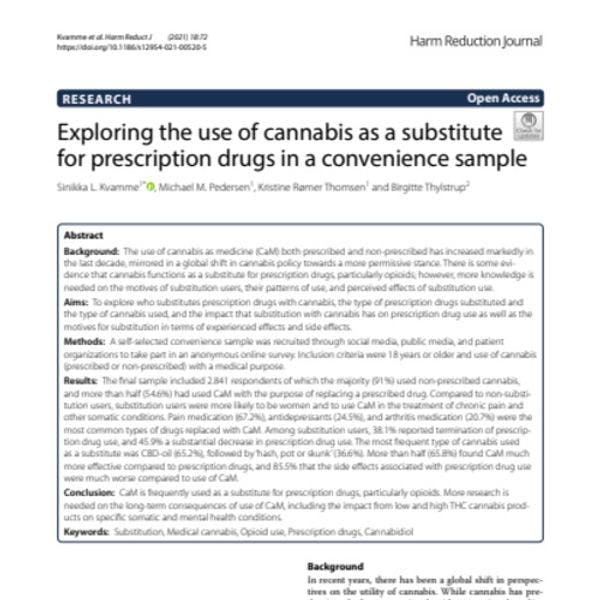Harm Reduction Journal
Exploring the use of cannabis as a substitute for prescription drugs in a convenience sample
By Sinikka L. Kvamme et al. / Harm Reduction Journal
In recent years, there has been a global shift in perspec- tives on the utility of cannabis. While cannabis has pre- dominantly been associated with recreational and/or problematic use, the plant or its components, cannabi- noids, are increasingly regarded as a viable treatment option for medical conditions, such as chronic pain, spasticity, nausea, and epilepsy, and as a potential treatment of other conditions.
The medicalization of cannabis is in large part driven by the discovery of the endocannabinoid system in the late eighties, pharmaceutical interests in cannabinoids, and a growth in user demand for access to medical cannabis (cannabis prescribed by a doctor). Tis development is mirrored in the rapidly shifting policy on the adoption of medical cannabis laws in more than 30 states in the USA, Australia, Canada and several European countries, including Denmark. However, the introduction of medical cannabis into medicine is controversial and highly debated. While critics caution use of medical cannabis due to the limited high-quality evidence, proponents argue that medical cannabis constitutes an important harm reduction strategy and may function as a qualifed substitute for prescription drugs, particularly opioids in the context of the opioid-epidemic in the USA and Canada.
In drug research, the term “substitution” is conventionally associated with the use of opioid antagonists, such as methadone, in the treatment of opioid addiction. Te concept of substitution has its origins in behavioral economics and involves the assessment of the interaction of multiple concurrent commodities. According to this concept, a substance is regarded as a substitute if it acts as a replacement, or leads to reduced use of another substance (e.g., treating heroin addiction with buprenorphine). Conversely, two substances may be complimentary when the increased consumption of one substance enhances the consumption of the other (e.g., tobacco smoking is often linked to excessive use of alcohol). Lastly, if there is no interaction on consumption patterns between substances, they are independent (e.g., it has been found that a change in price of alcohol has no impact on consumption of ecstasy).
